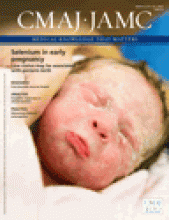Varenicline and smokeless tobacco
Although not approved for this use in Canada, varenicline may be helpful in cessation of smokeless tobacco. Users may believe that smokeless tobacco has few health risks, but it is associated with an increased risk of oral cancer. To date, pharmacologic treatments have not proven effective for quitting smokeless tobacco, although behavioural therapies have shown greater promise. The efficacy and safety of varenicline for quitting smokeless tobacco was assessed in a randomized, double-blind, placebo-controlled trial involving 430 men and women living in Norway and Sweden. The continuous abstinence rate at weeks 9–26 was 45% in the group treated with varenicline 1 mg twice daily for 12 weeks, compared with 34% in the placebo group (Table 1). These results mean that nine users of smokeless tobacco trying to quit would need to take a course of varenicline to have one succeed at around six months, a rate similar to that seen in smoking cessation. Although one-third of those taking varenicline experienced nausea, only 9% discontinued treatment. See BMJ 2010; 341:c6549 doi:10.1136/bmj.c6549.
Patients with continuous abstinence on varenicline versus placebo at end of treatment*
Occult lymph-node metastases in node-negative breast cancer
Does missing occult metastases in routine analysis of sentinel lymph nodes when staging affect survival in breast cancer? In this subanalysis of the National Surgical Adjuvant Breast and Bowel Project trial B-32, the researchers concluded that there was a small reduction in survival, but additional analysis of sentinel nodes was unlikely to have benefit at the clinical level. Other factors (age, tumour size, treatment choices) appear to have a larger influence on survival. Over 5600 women with operable, clinically node-negative, invasive breast cancer were randomized to sentinel node biopsy plus axillary dissection or sentinel node biopsy alone. In 71% (3989) of these women, no metastases were detected in initial evaluation. When the specimens were analysed further, occult metastases were detected in 15.9% (616) of these patients. The unadjusted hazard ratio for death was 1.37 (95% confidence interval [CI] 1.03–1.81). This translates into an absolute difference in the five-year estimate of overall survival between those with detectable occult metastases and those without of 1.2% (p = 0.03). See NEJM 2011;364: 412-21.
Blood pressure levels in late adolescence and mortality
As in older people, there is increased risk of death over time with higher systolic blood pressure measured in late adolescence. In this Swedish cohort study, low systolic blood pressure also contributed to increased mortality (mainly noncardiovascular). The pattern was different for diastolic blood pressure, where there was a threshold (about 90 mm Hg) above which both cardiovascular and noncardiovascular mortality increased sharply (hazard ratio 1.35, 95% CI 1.26–1.45). In this nationwide study of military conscripts, over 1.2 million men who had clinical examinations around age 18 years were followed for a median of 24 (range 0–37) years. Almost 29 000 men (2.4%) died during the follow-up period. Because elevated diastolic or systolic blood pressure measured in late adolescence appears to be related to increased mortality in white European young men at least, one wonders whether younger people should be screened for hypertension. It is not clear, however, why a low systolic blood pressure in late adolescence would contribute to increased noncardiovascular mortality. See BMJ 2011;342:d643 doi:10.1136/bmj.d643.
Exposure to micro-organisms and asthma in childhood
Children on farms are more exposed to potential allergens, and this exposure may reduce the likelihood of atopy and asthma. In this analysis of two large observational studies involving over 16 500 schoolchildren living in rural areas in central Europe, the prevalence of asthma and atopy was lower in children who lived on farms than in those who lived in a nonfarming environment. From assessment of dust samples taken from the mattresses or air in their bedrooms, children on farms had a wider range of exposure to micro-organisms. This exposure was inversely related to the development of asthma in both studies (odds ratio [OR] 0.62, 95% CI 0.44–0.89; and OR 0.86, 95% CI 0.75–0.99), which largely explains the protective effect of the farming atmosphere on the development of asthma in children that has been observed in other studies. Perhaps exposure to allergens early in life does more good than harm. See NEJM 2011;364:701–9.











